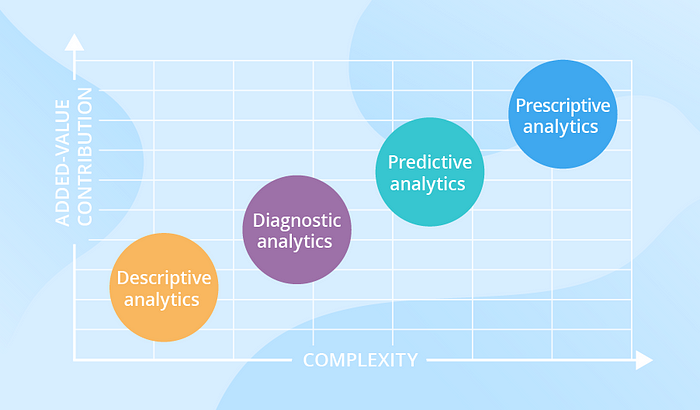Knowing what’s coming next can be tricky in a constantly shifting business world. That’s where data analytics steps in. A successful data analytics effort can give you a clear picture of your current situation, where you’ve been, and where you should head next. The IT industry generally recognizes four main types of data analytics:
Descriptive analytics:- This tells you what’s happening.
Diagnostic analytics:- This helps you understand why something is happening.
Predictive analytics:- This forecasts what might happen in the future.
Prescriptive analytics:- This recommends actions to take.
Each type of data analytics has a different goal and place in the analysis process and answers a specific question. Take a look at the diagram below to see the varying levels of complexity and value-add for these four analytics approaches.

Analytics tasks range from basic to complex. The chart shows how difficulty rises with each type. Simple descriptive analysis demands less effort, while advanced prescriptive analytics needs more resources. But as tasks get harder, the insights gained become more valuable.
1. Descriptive Analytics:-
Descriptive analytics is the most basic kind of data analysis. It answers the question “What is happening?”. This type of analysis looks at historical and current data to show business patterns and trends. Descriptive analytics takes raw data from different sources and turns it into valuable insights about the past and key metrics for a business. These insights can signal that something is right or wrong, but they don’t explain why. However, they can help identify the biggest issues to investigate further.
Some examples of data used for descriptive analytics include:-
Number of subscribers for a service
Customer satisfaction survey results
Monthly revenue reports
Daily stock reports
Demographic data about a business’ customer base, like the percentage that are self-employed
2. Diagnostic Analytics:-
After asking the question “What’s happening?”, the next step is to dig deeper and ask “Why?”. For example, “Why are these trends and patterns occurring?” This is where diagnostic analytics comes into play. Diagnostic analytics takes the insights from descriptive analytics and dives deeper to identify the root causes of specific issues. Businesses use diagnostic analytics because it helps them make stronger connections between data and uncover patterns of behavior.
Here are some examples of how diagnostic analytics is used:-
A freight company investigates why shipments are slow in a particular region.
A healthcare company examines patient diagnoses and prescribed medications to identify any connections.
An IT company analyzes server ticket data to pinpoint the specific servers causing the majority of service outages.
3. Predictive Analytics:-
Predictive analytics is about forecasting the future. This type of analytics uses past data to make predictions. Whether it’s the likelihood of a future event, forecasting a quantity, or estimating when something might happen these are all done through predictive models. In an uncertain world, being able to predict helps businesses make better decisions. Predictive analytics often relies on advanced techniques like machine learning and deep learning.
Here are some examples:-
A software company uses customer segmentation to find sales leads.
A car company forecasts the failure rate of a vehicle part to plan service actions.
A weather forecaster analyzes current conditions in one place to predict future weather in other places.
4. Prescriptive Analytics:-
Prescriptive analytics combines insights from previous data analyses to determine the best course of action to address a problem or make a decision. The purpose is to prescribe what action to take to prevent future problems or capitalize on promising trends. Prescriptive analytics is often used for multiple actions rather than just one. This requires a major commitment from businesses in terms of strategy, effort, and resources. More companies will adopt this data-driven approach as technology improves and more professionals are trained in data analysis. Prescriptive analytics utilizes advanced tools and technologies like machine learning, business rules, and algorithms. This makes it sophisticated to implement and manage.
For example,
prescriptive analytics can be used to create an exam timetable that checks for and resolves any conflicts in students’ schedules.
Artificial intelligence (AI) systems from data-driven companies like Facebook, Instagram, and Netflix
The different types of data analytics are interconnected and build upon each other. Each approach serves a distinct purpose and offers unique insights. As you move from descriptive analytics to predictive and prescriptive analytics, the technical complexity increases, but this also unlocks greater insights for organizations.
